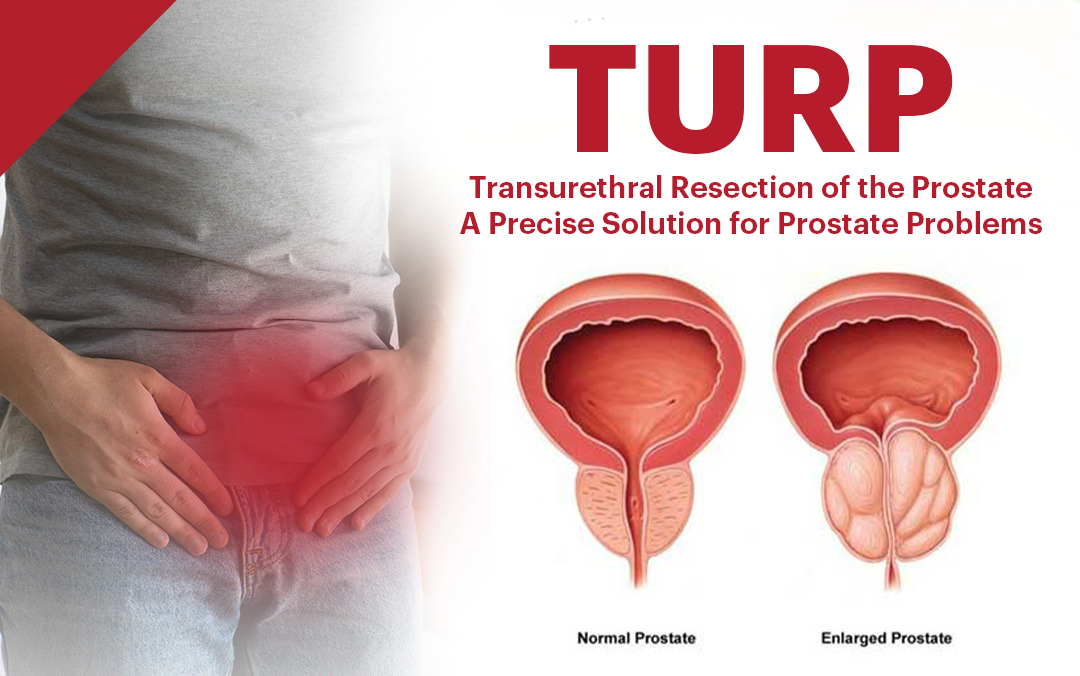

TRANSURETHRAL RESECTION OF THE PROSTATE (TURP): A PRECISE SOLUTION FOR PROSTATE PROBLEMS

The human body is a remarkable piece of biological engineering. Yet, as time takes its toll, various parts can experience wear and tear, leading to conditions that require medical intervention. The prostate, a small gland in men responsible for producing seminal fluid, can be one such source of concern.
In cases of an enlarged prostate, a condition medically known as benign prostatic hyperplasia (BPH), Transurethral Resection of the Prostate (TURP) stands as a precise and effective solution. In this educational content, we will delve into the intricacies of TURP, exploring its indications, the procedure itself, recovery, potential complications, and its importance in modern urology.
Understanding BPH and the Need for TURP
1. Benign Prostatic Hyperplasia (BPH): BPH is a common condition among ageing men, where the prostate gland enlarges, pressing against the urethra and causing urinary symptoms. This benign growth, while not cancerous, can significantly impact a man's quality of life.
2. Indications for TURP: TURP is typically recommended when BPH symptoms become severe, leading to complications such as urinary retention, kidney damage, recurrent urinary tract infections, or when conservative treatments like medications prove ineffective. It's important to note that TURP is not a procedure for treating prostate cancer.
The TURP Procedure
1. Anesthesia: TURP is conducted under anesthesia, either general or spinal, ensuring the patient's comfort throughout the surgery. The choice of anesthesia depends on the patient's health and the surgeon's preference.
2. Instrumentation: The TURP procedure relies on a resectoscope, a specialized instrument that's inserted through the urethra. This device combines a light source, a camera, and a cutting instrument.
3. Resection: The surgeon skillfully removes the excess prostate tissue that constricts the urethra using the cutting instrument on the resectoscope. This precise tissue removal results in an immediate improvement in urinary flow.
4. Irrigation: To maintain a clear view and flush out the resected tissue, sterile fluid is continuously circulated into the bladder during the procedure.
5. Catheter Placement: At the conclusion of the procedure, a urinary catheter is usually inserted to facilitate bladder healing. This catheter is typically removed within a few days.
Recovery and Aftercare
1. Hospital Stay: Following TURP, most patients spend a day or two in the hospital for observation. The exact duration varies depending on the patient's condition and response to the surgery.
2. Recovery Time: The recovery process involves some discomfort, blood in the urine, and urinary urgency. These symptoms can persist for several weeks but gradually subside. Full recovery may take up to six weeks.
3. Follow-up: Regular follow-up appointments with the urologist are essential to monitor the healing process and address any concerns or complications.
Potential Complications
1. Bleeding: While some blood in the urine is expected after TURP, severe bleeding can rarely occur, necessitating further treatment or surgery.
2. Infection: Infections are relatively rare, but they can happen. Symptoms may include fever, chills, or persistent pain, and treatment with antibiotics may be required.
3. Erectile Dysfunction: Although TURP is primarily intended to relieve urinary symptoms caused by BPH, it can occasionally result in temporary or permanent erectile dysfunction.
4. Urinary Incontinence: Temporary urinary incontinence is common after TURP, but most patients regain control over time. Pelvic floor exercises and lifestyle adjustments can help manage this side effect.
5. Urethral Stricture: In some cases, urethral strictures, or narrowing of the urethra, can develop after TURP. These may require additional medical intervention.
Alternatives to TURP
1. Medications: For individuals with mild to moderate BPH symptoms, medications like alpha-blockers and 5-alpha reductase inhibitors may provide relief by relaxing prostate muscles or shrinking the gland.
2. Minimally Invasive Procedures: Some patients may opt for minimally invasive alternatives to TURP, such as GreenLight Laser Therapy, UroLift, or Transurethral Microwave Therapy, depending on their unique medical circumstances and preferences.
Conclusion:
Transurethral Resection of the Prostate (TURP) is a well-established and effective surgical procedure used to alleviate the troublesome symptoms of benign prostatic hyperplasia (BPH). It offers a precise solution to an age-related condition, helping men regain their quality of life by improving urinary function. Patients considering TURP should consult with their urologist, who can guide them through the decision-making process, considering risks, benefits, and alternatives, in order to achieve the best possible outcome for their unique circumstances.














